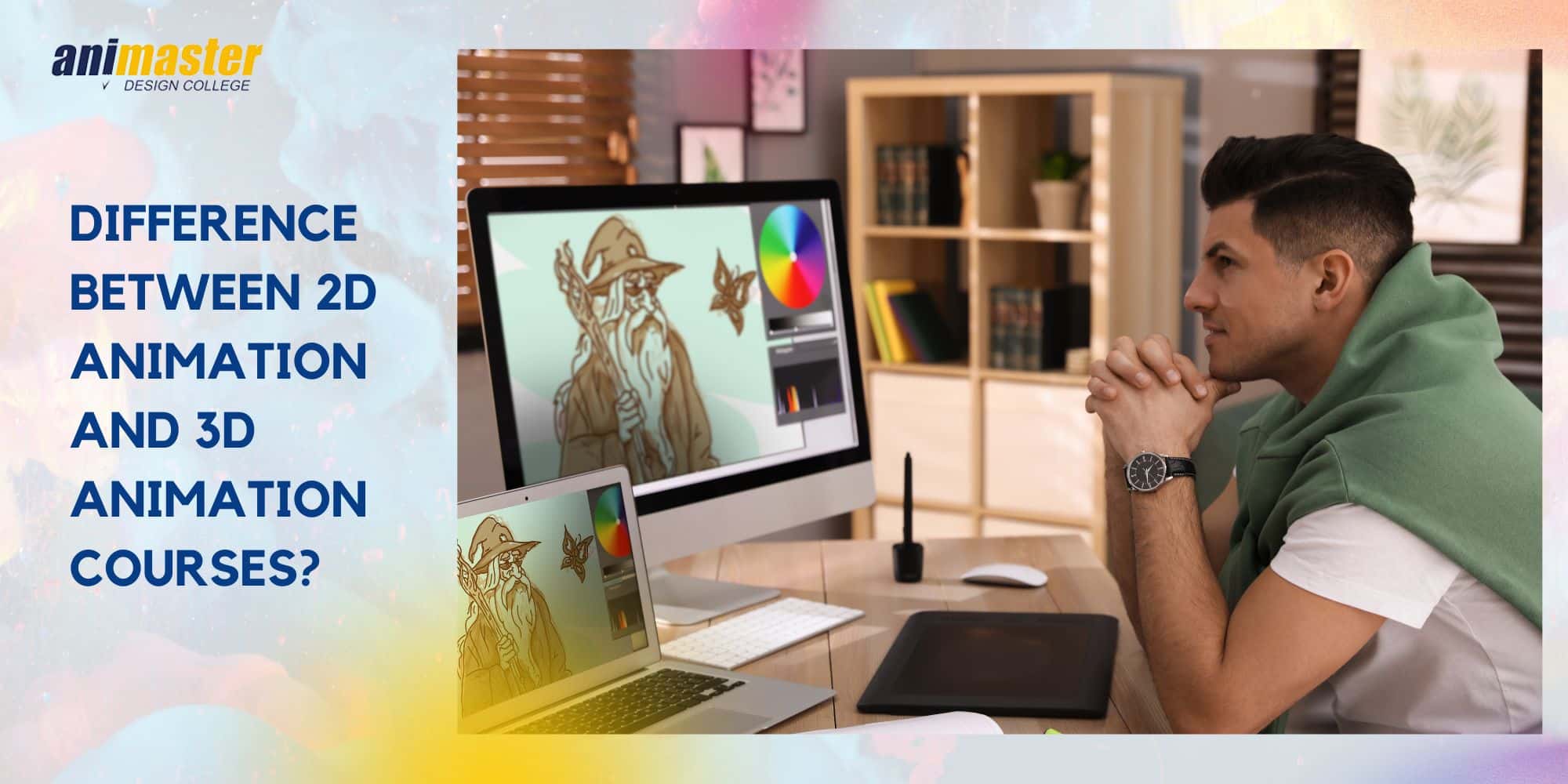
What is the difference between 2D animation and 3D animation courses?
Do you also wish to make a quirky and exciting career in the animation world?
Great! Then this article is for you.
Introduction
When one wants to make a career in the field of animation one needs to understand the difference between 2d & 3d animation courses. The key focus in 2D animation is generating two- two-dimensional, flat pictures that give off illusion when they move. The perfect example to describe 2D images is traditional cartoons which were drawn by hand.
Whereas, 3D animation involves developing three-dimensional atmospheres and objects. The main plus point of making 3D images is that they provide realistic and embedded animations. The most practical example of 3D image is animations in movies, video games, etc.
Difference between 2D Animation & 3D animation courses.
1. Medium and technique
2D animation- It includes animations in two dimensions. The main focus of 2D animation is on flat surfaces, attractive characters and atmosphere.
3D animation- many software create figures in three-dimensional space. It moves around 3D animation of objects in virtual environments.
2. More realistic
2D animation- They are considered to be more attractive but the objects in 2D animation are not that realistic looking as they are developed on flat surfaces.
3D animation- 3D animations offer more realistic images that are mostly used in movies, video games, etc. This helps to present and give experience of real-life atmosphere and figures.
3. Sophistication
2D animation – The biggest advantage while discussing the difference between 2D Animation & 3D Animation is that generally 2D images are more easy and simpler in terms of object movement and atmosphere.
3D animation- This 3D animation is more complex and sometimes becomes very hectic to generate the moment of objects and create a real-life environment.
Animation career in Bangalore
Animation courses in Bangalore offer a fun and creative outlet for individuals who want to enter the dynamic world of animation. Bangalore offers a rich ecosystem for learning design with many respected institutions. Here are some of the best features of animation classes in Bangalore.
Bengaluru has a wide variety of animation courses, ranging from 2D and 3D animation to visual effects and game design. This variety allows students to choose programs that match their unique interests and career goals.
The city’s amazing IT and design industries provide excellent networking and training opportunities for students. There are many animation studios and multimedia companies in Bangalore, offering crafts and services that they can offer.
Also, Bangalore’s position as a technological hub ensures that animation students have access to the latest software and hardware tools, ensuring that they stay ahead of industry trends. Hence, starting your animation career in Bangalore will be extremely fruitful.
Career in animation
The animation industry in India has steadily grown over the years, as the 2D and 3D animation courses are providing career opportunities for individuals interested in animation.
Here are the popular roles you can opt for after learning animation:
Basic training and education:
To start a career in animation, individuals generally undertake formal courses in animation and related fields. There are many animation institutes and universities all over India offering courses in animation.
Entry-level positions:
After completing their education, graduates often start their careers in entry-level positions such as 2D/3D animators, graphic designers, storyboard artists, musicians etc. These roles require them to create visuals for animations, cartoons and commercials.
Specializations in that field:
As you gain experience, you can specialize in areas such as character animation, visual effects, modelling, texturing, lighting, etc.
Production Studios:
There are many animation production studios in India, big and small, that produce products for various platforms like television, movies, commercials, games, etc. The work done in these studios can provide industry valuable experience.
Freelance work:
Many animators also choose to freelance, offering their services on a per-job basis. This allows for work flexibility and the opportunity to collaborate across projects.
Game Industry:
The game industry often interacts with animation and provides opportunities for animation designers to work on game design, character design, and visual effects for videos.
Conclusion
I hope that after going through this article you will be able to understand that both 2D and 3D animation courses offer aspiring animators a distinct but equally valuable set of skills. 2D animation courses focus on the fundamentals of hand-drawn and digital animation. You can look for a good potential career after acquiring these skills by getting hands-on practical experience with it.
FAQs
Ques:1 Is it better to study 2D or 3D animation?
Ans- This can be easily understood by understanding the difference between 2D &3D Animation. 2D animation is great for those interested in traditional craft animation, creating people and storytelling. It is frequently used in TV shows, web series and some movies.
Strong drawing skills and a strong understanding of anatomy and movement are required for this. Whereas if you wish to work in the game industry, VFX for movies, or 3D modelling. Having experience working with 3D software and a strong understanding of 3D modelling and animation methodologies is required. Some animators even choose to learn both 2D and 3D techniques to increase their knowledge on the job. Hence, you can choose as per your interest.
Ques 2: Which is more difficult, 2D animation or 3D animation?
Ans- Practically, the complexity of 2D animation and 3D animation can vary depending on the specific project and the experience of the animator. 2D animation problems can range from very simple graphics to complex and very detailed ones. If we compare, 3D animation can be difficult due to technical aspects such as creating realistic physics and lighting. The difficulty level can also be understood by knowing the content of 2D and 3D animation courses.
Ques 3 :What is the difference between a 2D and 3D animation career?
Ans- 2D animation is considered a little easy due usage of simpler tools and work primarily focuses on two-dimensional, flat, and often hand-drawn animation. This includes skills in character design, storytelling, and traditional design techniques. This job allows you to work in areas such as TV shows, commercials and web content.
On the other hand, 3D animation requires proficiency in 3D modelling, rigging, texturing and animation software. Those animators typically work in industries such as film, video games, architecture, and visual effects.
The main difference is in tool usage and skill set. 2D animation tends to be more artistic and 3D animation more technically complex to understand and work with, but both can address business processes creatively.
Ques: 4 Are 2D animators in demand?
Ans- The demand for 2D animators can vary by location and industry, but in general, there is a demand for 2D animators who have expertise in industries such as entertainment, advertising, gaming, education, etc. 2D animators due to the increasing popularity of streaming platforms, online content creativity and mobile gaming. This implies that there is a great demand for 2D animators who possess the right skills and experience.
Ques: 5 Is 3D animation easier to learn than 2D?
Ans- 3D animation can be technically tested because it requires working with 3D software and understanding 3D modelling. But it is easier for some to understand because it mimics natural and real-world phenomena.
2D animation can be conceptually straightforward but can require strong graphic design skills and a good sense of time and movement.



